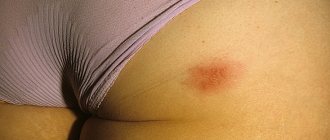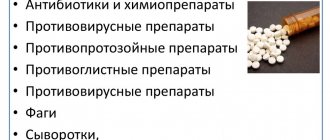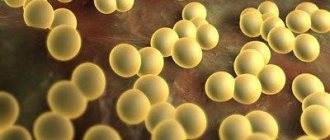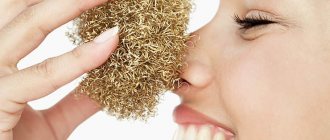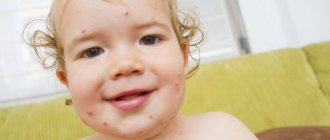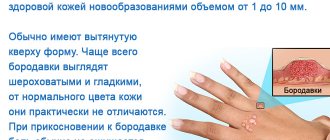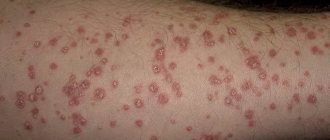Symptoms
From the moment of infection until the first signs of herpes appear on the wings of the nose, its tip or bridge of the nose, it can take about a month.
There are frequent cases of damage to the nasal mucosa. The symptoms are as follows:
- During the incubation period, a person experiences a burning sensation and pain in the area of future rashes. Redness of the skin is observed.
- A few days later, a herpetic vesicle with transparent serous contents appears on the nose. Over time, the infected fluid becomes cloudy.
- Herpetic eruptions break open, forming painful ulcers.
- After 3 days, the erosions dry out, and in their place a bloody crust forms, which will disappear in a few days, leaving no scars on the skin (if you follow the rules for treating herpes).
Dermatovenerologists distinguish 6 stages of herpes development: the precursor stage, the hyperemia stage, the vesicle stage, the erosion formation stage, the crust formation stage, and the healing stage.
During the initial episode of the disease, there may be a slight increase in body temperature and a state of general malaise.
After the disappearance of external signs, the virus enters an inactive phase, localizing in the trigeminal ganglia located in the cervical spine.
Cells affected by herpes die, and the virus is released and spreads to other cells. As a result, due to the death of the epithelial layer, characteristic signs appear - blistering rashes on the nasal mucosa or skin.
After the initial infection, the body begins to actively produce antibodies, leading to remission of the disease, which can last a very long time. When the immune system is weakened, herpes manifests itself again. And if, during the initial infection, bubble formations formed in the nasal cavity or on the tip of the nose, then with an exacerbation of the disease, the virus is guaranteed to manifest itself in the same area.
At the very beginning, there is redness and slight hyperemia inside the nose, against which small bubbles appear. One fireplace can contain more than a dozen of them. The bubbles are located close to each other. The formations contain a clear liquid inside. After a few minutes, the exudate becomes dark in color.
If you try to damage the blisters or scratch them, this will lead to inflammation of the mucous membrane, the formation of erosions, red ulcers, which will be accompanied by irritation, severe itching, tingling, burning and pain. In this case, there is a possibility of a secondary infection, which will worsen the patient’s symptoms and well-being.
You can see what herpes in the nose looks like in the photo.
The main symptom of the disease is the inflammatory process. The affected areas of herpes in the nose and on the nose acquire a characteristic reddish tint. Some swelling may be present. If, at the first signs of the disease, no targeted measures were taken to stop the pathology, the symptoms become more pronounced. People suffering from herpes in the sinuses complain of:
- pain;
- itching;
- tingling;
- irritation of the mucous membrane.
Foci of inflammation in most cases are present not only on the mucous membrane inside the nose, but also on its surface. As the ulcers dry out and crusts form, a runny nose mixed with blood often appears. This symptom is the result of trauma to the mucous membrane. If the vessels are located close to the surface, nosebleeds are possible.
If a person first experiences symptoms of herpes in the nose, then symptoms of general intoxication may occur, expressed by increased body temperature, chills and decreased appetite. In case of relapses, only local manifestations are observed.
Small ulcers filled with cloudy liquid (exudate) are the main manifestation of the disease. They can be noticed even in the early stages of herpes development. In most cases, rashes appear when the pathology recurs in the same places.
Later they become covered with a dense brown crust. The appearance of blisters on the wings of the nose leads to inflammation of healthy tissue around such lesions. The affected areas appear red and slightly swollen. Healthy skin surrounding the vesicles is tight and dry.
Many people believe that herpetic rashes appear exclusively on the lips, but this is not true: the location of the rash depends on where the virus penetrated during the initial infection. Herpes on the nose occurs as often as a cold on the lips, it is caused by the same pathogen, infection most often occurs at an early age.
Herpes on the nose occurs as often as a cold on the lips, it is caused by the same pathogen, infection most often occurs at an early age.
Symptoms
Herpes on the skin of the nose develops in several stages, each of which has its own symptoms:
- Prodromal period. There is itching, burning and soreness of the skin on the wings of the nose and its tip, in the area of the bridge of the nose or nasolabial triangle. This stage often goes unnoticed, because there are no characteristic signs of herpes during this period, and the discomfort present is of low intensity.
- Stage of rash onset. During this period, swelling and redness of the skin is observed, and the first herpetic blisters appear. The elements of the rash are filled with liquid containing a large number of viral particles. At this stage, the person is considered dangerous to others. Bubbles can appear individually or in groups.
- Opening the bubbles. During this period, the contents of the vesicles are removed, leaving painful erosions on the skin. Elements of the rash may appear within 7-14 days, depending on the severity of the herpes.
- Healing stage. At this time, the bubbles become covered with crusts, after which no traces remain. The skin of the nose is thin and susceptible to irritation and injury, so after the rash disappears, prolonged peeling of the affected areas may occur.
Herpes on the mucous membranes inside the nose looks somewhat different. Due to the characteristics of the tissues, the rashes do not look like vesicles, but small abscesses. The high sensitivity of the mucous membranes and the presence of nerve endings contribute to the appearance of more intense pain and discomfort.
The elements of the rash are filled with liquid containing a large number of viral particles.
Herpes on the skin of the nose of a child or adult appears when the herpes virus, which is present in the body of the majority of the inhabitants of our planet, is activated. Provoking factors include:
- weakening of immune defense;
- respiratory infections;
- hypothermia or overheating of the body;
- depressive disorders and stress;
- vitamin deficiency;
- poor nutrition;
- injuries and surgical interventions;
- uncontrolled use of antibiotics;
- allergic reactions;
- autoimmune pathologies;
- hematopoietic disorder;
- HIV infection;
- endocrine diseases;
- menses;
- intoxication of the body;
- chronic fatigue;
- presence of bad habits.
If a herpes has popped up near your nose, and this happens often, it is recommended to visit an immunologist. When immune cells are in a normal state, rashes on the lips and nose rarely appear.
If a herpes has popped up near your nose, and this happens often, it is recommended to visit an immunologist.
The greatest danger to others is a person with an active form of the disease. Herpes is transmitted:
- By contact. The virus enters the body through kissing and touching damaged areas of the skin.
- Contact-household way. Infection occurs through the use of shared utensils, bed linen, towels, and hygiene items.
- During the period of intrauterine development and childbirth.
- By airborne droplets. Viral particles are found in the saliva and nasal secretions of a person with an acute form of herpes.
We suggest you read: How to treat the consequences of herpes zoster
How and with what to quickly cure herpes on the nose
If the immune system is normal, specific therapy for the disease is not required. During the acute period, it is recommended to limit contact with healthy people and observe personal hygiene rules.
It is possible to quickly cure herpes if you start using antiviral drugs 1 day before the rash appears.
If the immune status is low, additional examination is carried out and complex treatment is prescribed.
Diagnostics
In order to clarify the diagnosis, the doctor prescribes laboratory tests that help identify type 1 herpes in the body:
- PCR study. It involves the isolation of herpesvirus DNA from the biomaterial of a sick person.
- Linked immunosorbent assay. Helps identify antibodies to the pathogen in the blood. Using this method, it is possible to determine the type and phase of herpes.
- Cytological analysis - examination of scrapings from the affected areas of the skin of the nose.
How to treat?
To eliminate the unpleasant symptoms of the virus and speed up the recovery process, the following remedies are used:
- Ointment based on acyclovir (Zovirax and Acyclovir-acri). Prevents the spread of rashes to healthy areas of the skin, eliminates itching and burning, and promotes rapid healing of ulcers. The drug is applied every 4 hours in a thick layer. The course of treatment is 5 days.
- Panavir-gel. Antiviral agent based on natural extracts.
- Antihistamines (Loratadine, Suprastin). Used for symptomatic treatment of herpes.
- Immunostimulants. Increases the body's resistance and prevents the development of dangerous complications.
- Antiviral tablets (Famciclovir, Valaciclovir). Systemic therapy is prescribed for the development of immunodeficiency states and severe disease.
- Antibacterial ointments. Prevents secondary infection of affected areas by representatives of bacterial flora. Can be used to treat rashes on the nasal mucosa.
- Erazaban ointment. The active ingredient of the drug (docosanol) prevents the penetration of herpes into cells.
Folk remedies
Causes of the disease and its symptoms
Herpes in the nasal area appears after viral particles enter the nasal mucosa or skin. The infection can be spread through direct contact, such as kissing, or after using contaminated items such as a towel or bedding.
If a sick person sneezes or coughs nearby, there is a high probability that nasal herpes will appear. The virus easily enters the body, and after a few days rashes can be observed on the nasal mucosa. In children, infection can occur during childbirth if the woman has suffered from this disease.
The first signs of herpes on the face.
Once it enters the body, the virus remains in it forever and, with any weakening of the protective forces, appears on the mucous membrane or on the skin. A cold in the nose, just like a cold on the nose, can recur after hypothermia, during exacerbation of chronic diseases, after stressful situations and when the immune system is weakened.
The incubation period for a cold in the nose can last up to 10 days. After this, the patient experiences a burning sensation, itching and irritation on the nasal mucosa, and internal hepatitis develops. Many patients do nothing in this case and mistakenly think that everything should go away on its own. But this does not happen, the unpleasant sensation in the nose does not go away, and after a few days the patient develops a headache, fever and general weakness.
The patient begins to notice that the skin around the nostrils and mucous membranes have turned red. If treatment for herpes in the nose is not started at this stage, other symptoms will appear and treatment will take longer. In the future, painful blisters may appear on the mucous membrane, spreading to the area of the nasolabial triangle. These blisters are very painful, after a few days they begin to darken and then burst.
The liquid released from the blisters contains a huge amount of viruses; when it gets on healthy skin, the infection quickly spreads. If the infection is primary, then herpes in the nose (its acute stage) lasts about 5 days. The ulcers formed at the site of the vesicles heal in a couple of days.
Only a doctor, whom you should contact when the first signs of the disease appear, can tell you exactly how to get rid of a cold in the nose. After a thorough examination, the attending physician will make an accurate diagnosis and prescribe the necessary treatment.
Causes of herpes in the nose
The main cause of herpes in the nose is the herpes simplex virus (type 1). You can become infected with it through airborne droplets (coughing, sneezing), through contact with the mucous membranes of an infected person (kissing), as well as when the virus gets into microcracks formed on the skin during the use of the infected person’s personal belongings.
It’s easy to catch the virus – just contact with the mucous membranes of an infected person or inhalation of contaminated air. During primary infection, herpes, having entered the body, penetrates the epithelial cells lining the mucous membranes and begins to actively multiply in them.
The virus can be activated by weakening the body’s immune functions. A number of factors contribute to this, namely:
- hypothermia;
- previous colds;
- poor nutrition;
- stressful situations;
- reluctance to move;
- addiction to alcoholic drinks, smoking;
- avitaminosis;
- chronic diseases in an acute form;
- long-term use of antibiotics;
- In women, there is a connection between the menstrual cycle and exacerbations of herpes.
Folk remedies for treating a viral infection in the nose
Herpes in the nose can be treated not only with medication. Traditional medicine will be an excellent help. Many of the remedies were used by our ancestors. The products still show their effectiveness today.
We bring to your attention the following traditional medicine:
- Propolis infusion. This product is absolutely easy to prepare at home. It can also be found at any pharmacy. Before using this product, it must be diluted in a 1:1 ratio with drinking water. Propolis allows you to thoroughly rinse your nasal passages.
- Ointment with calendula. Since ancient times, a plant such as calendula has been valued and has always been used in medicine. But it’s true that this plant is famous for its amazing anti-inflammatory properties. You will need to use a dried plant. It needs to be crushed until it becomes powdery. Afterwards, a teaspoon of the resulting powder should be mixed with Vaseline. Next, the product should infuse. It must be left in a dark and cool place. It is then used to treat the affected area of the nose. If treatment is timely, then in a short time there will be no trace of the symptoms.
- Fir oil. To get rid of unpleasant and painful sensations, we recommend using fir oil. It also gives an excellent antiseptic effect. You just need to treat the inflamed areas in the nose with oil. Treatment should be carried out no more than five times daily. You can find such a remedy in almost any pharmacy.
- Aloe extract. Aloe has always been used in medicine. This plant is one of the best helpers for treating herpes. It is famous for its antiseptic and soothing properties. To begin treatment you will need to use a fresh leaf. It must be cleared of skin and thorns in advance. Then the leaf needs to be crushed. Afterwards the juice itself is squeezed out, with the help of which all the treatment is carried out. They need to lubricate the nasal mucosa. This should be done three times a day. With regular use of this plant, further spread of the virus will stop.
Deviated nasal septum: main symptoms and treatment methods
Important! Often traditional medicine methods are not used as the main treatment. Only as an additional treatment.
Causes
Rashes on the lips and nose appear during the period of activation of type 1 herpes virus cells. The disease cannot be cured. Exacerbation of herpetic infection occurs in a number of cases:
- Hypothermia or excessive exposure to direct sunlight.
- Weakening of the immune system. Frequent colds.
- Antibiotic therapy.
- Systematic stress exposure.
Taking some antibiotics can cause rashes on the nose.
With colds, there is a high risk of developing herpes.
Rashes on the nose may appear due to hypothermia.
Stressful situations can trigger the appearance of herpes.
The disease is often transmitted by contact (by contact with the affected area of another person), which is typical for both the primary episode and the recurrent form.
If a person has a strong immune system, then there may be no symptoms.
There are other ways of transmitting herpes:
- Household - when using personal hygiene items of an infected person.
- Airborne. There is a high chance of contracting the virus if someone with herpes sneezes or coughs near you.
- From mother to child during intrauterine development or during passage through the birth canal.
Herpes is transmitted from mother to child during fetal development.
If you use personal hygiene items from an infected person, you can become infected with herpes.
There is a high chance of contracting the virus if someone with herpes sneezes or coughs near you.
Characteristic signs of the disease
At the very beginning, this virus affects the internal tissues of the nose, and only then does it appear externally. A characteristic sign of herpes is swelling and pain in the nose. Itching may also occur. If a person was previously susceptible to this disease, then you must be sure that herpes has returned again. As soon as immunity decreases, the virus reappears.
A rash on the lips and a rash on the nose are no different. Small blisters are covered with skin, and as soon as it cracks, a colorless liquid appears from under it. The inflamed area then ulcerates and only then heals.
Often the disease goes away with a runny nose, headache, and an increase in body temperature is also observed due to the fact that a weakened immune system at the same time provokes a cold.
Possible complications
In the absence of targeted complex therapy, herpes can acquire a chronic, recurrent form. And in the presence of reduced immunity, as the lesions heal, fresh vesicles may appear in their place. Frequent relapses of the disease can cause disruption of the mucous membrane. This is fraught with the development of rhinitis. It is extremely difficult to eliminate such a runny nose.
More dangerous complications due to herpes lesions of the mucous membranes are not observed in most cases.
A specialist may recommend using Polyoxidonium.
The chronic relapsing course of this disease indicates the presence of problems with the immune system. If you are suffering from herpes, then you need to consult an immunologist. This specialist may recommend the use of special immunomodulators. Such means include:
- Amiksin.
- Polyoxidonium.
- Arbidol
- Neovir.
These drugs can only be used after consulting a doctor. They have a number of contraindications and can aggravate the course of some chronic diseases.
The frequent appearance of herpetic rashes in the nasal area indicates a weakened immune system.
Complications rarely occur when the infection recurs. The acute form of herpes is characteristic of primary infection.
Do not touch herpetic rashes with your hands - this can spread the virus to the mucous membrane of the eye, which can cause conjunctivitis (more details here).
The herpes simplex virus damages brain cells, releasing a protein that forms amyloid plaques. This abnormal protein coating on nerve cells in the brain is considered a likely cause of Alzheimer's disease.
As a rule, when herpes is localized in the nasal cavity, no serious complications arise. People with immunodeficiency should be wary of the consequences. If the body is not able to resist infection, then the likelihood of it spreading to other organs increases significantly.
With herpes in the nose, the risk of infection in the eyes and mouth increases. For example, when rubbing the mucous membranes of the eyes and lips with a handkerchief on which remains of nasal mucus remain, or when touching these areas with fingers that touched the area affected by the virus.
How it proceeds
It is difficult to recognize infection of the nasal cavity with the herpes virus at the initial stage. Inflammation begins with a slight burning sensation, itching, tingling, irritation, and pain. Gradually the discomfort becomes obvious. Next, the virus is activated, affects the nasal passages, penetrates deeper, leading to a thickening of the mucous layer, the appearance of erosive rashes, which subsequently become covered with crusts.
Papules and vesicles, enclosed in a colorless thin skin, itch very much, begin to break out, and hurt on palpation. Gradually the rashes darken and burst. An infectious serous fluid is released from the wounds.
The main symptom during the activation period is itching followed by the formation of swelling and blisters on the mucous membrane . Associated symptoms:
- malaise, weakness,
- headache,
- swelling of the mucous membranes, nasal congestion,
- increase in local temperature.
Lack of early treatment can lead to widespread spread of the process.
If a bacterial infection occurs, then pus begins to leak from the erosive wounds. Treatment will require more time and effort, and the disease will become recurrent. The initial phase of herpes in the nose lasts no more than two days. Then the weeping ulcers gradually dry up. If the immune system is normal, a herpetic “cold” can be quickly cured. In most cases, the body copes with the pathogen on its own.
Herpes infection is considered opportunistic. The virus is more dangerous for children. The child has a weak immune system that is not fully developed, so his body is not able to fully resist pathogens.
Parents should monitor their children and be able to distinguish herpes in the nose from other diseases (lichen, furunculosis, candidiasis, thrush) with similar symptoms. A clear sign of herpes is small rashes that merge with each other, with a diameter of no more than 1 cm.
In adults
Acute symptoms increase over 2-3 days, after which a crust forms. In this age group, self-healing can also occur if the disease develops against the background of a cold. The use of antiviral drugs for local and internal administration can speed up the recovery process. During the treatment period, adults are advised to give up smoking and alcohol, and also follow a gentle diet.
The viral disease occurs in most cases in a mild form. It is perceived by adults as a temporary aesthetic defect.
It is worth consulting a doctor if you experience relapses of herpes more than 4 times a year.
Traditional methods of treatment and prevention
There are many folk recipes based on the use of medicinal plants. But before using them, you should definitely consult with your doctor to avoid possible serious complications.
You can buy fir oil at the pharmacy, which has excellent antiseptic properties. They lubricate the nasal mucosa several times a day. Propolis tincture diluted with water in a 1:1 ratio is used to rinse the nasal passages. It can also be purchased at a pharmacy.
You can prepare a healing ointment based on calendula flowers: 1 tsp. crushed dried flowers mixed with 1 tsp. Vaseline. This anti-inflammatory ointment is used to lubricate inflamed areas. It is useful to lubricate the mucous membrane several times a day with fresh aloe juice, this will prevent the spread of the virus. To strengthen the immune system, it is useful to drink herbal teas from chamomile, calendula or St. John's wort.
You can prepare an ointment based on calendula flowers.
To make treatment more effective, you must follow a special diet. Fatty, fried, spicy and sweet foods should be excluded from the diet. The menu during the treatment period should consist of fresh vegetables and fruits, and it is better to drink fermented milk drinks, herbal and green teas, compotes and fruit drinks. To cleanse the body of toxins, you need to drink up to 2 liters of liquid per day.
To avoid getting herpes, you need to strengthen your immune system. A healthy lifestyle, physical exercise and daily walks in the fresh air will help with this. Hypothermia, stressful situations and overwork should not be allowed.
It is necessary to observe the rules of personal hygiene, the items of which should be different for each person. During an acute respiratory viral infection or influenza epidemic, it is necessary to avoid places with large crowds of people. In spring and autumn, when viral diseases worsen, it is advisable to take a multivitamin complex.
If you find a cold in your nose, only a specialist can tell you how to treat it; self-medication can be very dangerous. Only comprehensive treatment and following all the doctor’s recommendations will help you effectively get rid of this unpleasant disease.
Tweet
Pin It
- Development of herpes zoster in children: symptoms and treatment
- Consequences and treatment of genital herpes during pregnancy
- Effective treatment of herpes zoster with folk remedies
- How does shingles manifest?
Diagnostic methods
It is not difficult to understand that herpes is the culprit of bubble formations in the nasal cavity. It is enough to conduct an external examination of the patient. However, laboratory tests are still necessary to determine the type of virus. For this, the patient is referred to:
- PCR diagnostics - necessary for early detection of pathogens;
- ELISA - detects the presence of specific antibodies - antigens - to certain pathogenic agents;
- immunofluorescence reaction (RIF) - detects herpes virus antigens in the blood;
- cytological research method - considered the most informative, carried out to determine viral changes.
We suggest that you familiarize yourself with the Diet for herpes: for herpes zoster, genital, on the body, lips, in the mouth, types 2, 6
In children
A peculiarity of the treatment of herpes in the nose of a child is that many antiviral drugs are prohibited for children under the age of 12 years. Therefore, if the emerging sores do not spoil the child’s life, then treatment in this case is not required.
The exception is unpleasant symptoms of the disease - burning, pain, tingling, itching. In this case, it is advisable to use antiviral drugs based on acyclovir:
- Zovirax ointment;
- Herpetad;
- Virolex.
A rash in a child’s nose can be lubricated with Erazaban, tromantadine-based products (Viru-Merz Serol), as well as propolis tincture, aloe juice, fir oil, and camphor alcohol.
In addition, it is recommended to take drugs that strengthen the immune system: ascorbic acid, fish oil (in the form of syrup), Viferon (in the form of rectal suppositories).
The difficulty of treating herpes in the nose during pregnancy is that many anti-inflammatory and antiviral drugs are prohibited due to their harmful effects on the fetus.
Therefore, before using any product, you should consult a doctor.
Most often during pregnancy, the doctor prescribes local antiviral ointments. The safest during this period is Panavir, as well as tetracycline, oxolinic, and zinc ointments. Acyclovir and Zovirax are prescribed only in the first and second trimester of pregnancy.
In this case, it is advisable to use rosehip and sea buckthorn oils, as well as aloe juice.
Treatment of herpes in the nose is prescribed depending on the specifics of the disease. If the infection is primary, it occurs with some complications, for example:
- headache;
- increased body temperature;
- general weakness and malaise;
- redness of the outer skin around the nose and swelling;
- thickening and inflammation of the mucous membrane inside the nose.
In this case, along with antiviral drugs, medications are prescribed to relieve other unpleasant symptoms. With secondary infection, the symptoms are less pronounced, the patient already knows that the precursors of herpes are a feeling of tightness, itching and tingling at the site of the future ulcer.
With the timely use of special ointments, in some cases you can even prevent the appearance of watery pimples. If the patient often suffers from relapses (more than 4 times a year), then immunomodulators are used along with local medications.
It is not recommended to use antiviral drugs in the age group under 12 years, because The child’s body must fight herpes on its own. In this way, antibodies to HSV are produced.
If the child’s primary infection is accompanied by fever and headache, the doctor may prescribe painkillers.
If a woman has a repeated exacerbation, the risk of infection is significantly reduced.
Features of treatment include the prescription of antiviral drugs for external treatment of the affected area.
For recurrent forms of herpes, immunoglobulin is administered intravenously.
Drugs in tablet form are used with great caution.
Herpes on the nose in pregnant women is treated using the following methods:
- Ozone therapy (use of reactive oxygen species to suppress the growth of virions).
- Hyperbaric oxygenation (therapeutic effects of oxygen under high pressure in a pressure chamber).
- Oral use of immunomodulators.
To treat herpes during pregnancy, doctors prescribe oral immunomodulators.
Herpes infection of the mucous membranes in children often occurs with symptoms of general intoxication. The disease is also accompanied by striking local manifestations. Due to the increased sensitivity of the skin and mucous membranes, the developing vesicles can cause great discomfort to the child.
In this case, treatment with antiviral drugs is supplemented with antihistamines, which help relieve unpleasant symptoms. Drugs and their dosages for the treatment of this age group should be prescribed by a specialist.
Due to the severe decrease in immunity observed during pregnancy, many women experience herpes in the nasal cavity. During pregnancy, therapy for this disease is carried out with interferons. The treatment regimen can include vitamin complexes and special ointments for local use, which can stop the manifestations of herpes. The drugs are selected so that their use does not harm the developing fetus.
Due to the severe decrease in immunity observed during pregnancy, many women experience herpes in the nasal cavity.
Types of herpes on the face
There are a large number of strains of the virus in question, but only 8 of them pose a danger to humans. Two types of infection cause rashes on the face: herpes simplex and Varicella zoster. The last indicated form is accompanied by different symptoms depending on the age of the patient and the activity of his immune system.
Herpes simplex on the face
This type of virus is the most common. Most people are only carriers of the infection; herpes on their facial skin does not cause any symptoms. In other cases, the pathology periodically worsens under the influence of external factors, which is characterized by a corresponding clinical picture. The rashes are localized mainly on the epidermis, but can also affect the mucous membranes.
When the virus recurs, herpes appears on the nose and lips (“colds”) in the form of clusters of small blisters. They quickly dry out and burst, especially with correct treatment, becoming covered with a thin crust. Sometimes simple herpes occurs on the chin and eyelids (conjunctivitis) with local inflammation. These symptoms are caused by a similar type of HSV-1 infection, so they are also easy to deal with. Gradually, herpes on the face worsens less and less. This occurs due to the formation of specific antiviral immunity.
Herpes zoster on the face
The described form of infection occurs in 2 variants:
- chicken pox – first contact with the virus, most often occurs in childhood;
- herpes zoster on the face – re-infection or relapse of Varicella zoster.
With chickenpox, small blisters with purulent fluid cover the entire body, sometimes forming on the mucous membranes. The rash characteristic of herpes zoster is localized on the torso in most patients, but blisters can also appear along the trigeminal facial nerve. In such situations, herpes is observed on the inside of the cheek. In parallel, bubbles appear in the external auditory canal and on the ears.
How to treat herpes under the nose and is it possible to get rid of it quickly?
For herpes in the nose, pharmaceuticals are successfully used together with traditional medicine.
Treatment with drugs
Using only antiviral tablets or ointments that relieve symptoms when treating a herpes virus infection is not enough. Monotherapy, as a rule, resembles a vicious circle from which it is almost impossible to get out. As a result, the patient receives stress, which further aggravates the situation.
To get rid of herpes in the nose, they should be taken in a course of at least 5 days. After treatment, the number of viruses in the body decreases noticeably.
Then an immunotherapeutic agent, Alpha interferon, is necessarily prescribed. The duration of taking the medicine depends on the degree of the infectious process and the state of the patient’s immune system.
The following ointments and gels will help you quickly get rid of herpes:
- Levomekol;
- Celestoderm;
- tetracycline ointment;
- zinc ointment.
If you have a cold, you should apply ointments carefully using an ear stick or turunda. It is recommended to smear a cold 3 times a day.
Home and folk remedies for a cold in the nose are used only as an addition to the main treatment. Their main task is to accelerate the healing process of herpetic formations in the nasal cavity and eliminate discomfort.
Once the herpes simplex virus enters the body, it cannot be cured. It is in the human body in a dormant state. When immune function decreases, the virus becomes more active, causing cold-like rashes on the skin or mucous membranes, including herpes localized under the nose.
Herpes under the nose is caused by HSV type 1, which is a viral disease. It is transmitted by airborne droplets and household contact, vertically (from mother to fetus through the placenta), during childbirth, through blood transfusion, and during sexual contact. Once the virus enters the bloodstream, it migrates to the nervous tissue. The majority of the population is infected with it, but it is not dangerous to human life.
Once in the body, herpes is there in a latent form without clinical manifestations. HSV is activated when unfavorable factors arise (cold body, stress, frequent illnesses) and begins to actively develop. Rashes usually appear under the nose, on the lips, and on the mucous membrane of the pharynx.
Manifestations of the disease depend on the accumulation of HSV and the state of immunity. The following signs of herpes are distinguished:
- the appearance of characteristic bubbles with a clear liquid containing the virus under and inside the nose;
- low-grade fever (increase in temperature in the morning to 37.5 degrees, decrease in the evening);
- itching, redness, swelling of the skin around the rash;
- If left untreated, the blisters burst, forming erosions or ulcers.
Symptoms of the disease depend on the state of the immune system and the causes of herpes. The more a person suffers from colds, ARVI, flu, infections, the more often herpes is activated, causing the appearance of symptoms. With immunodeficiency, rashes form constantly and cannot be controlled.
To prevent the development of HSV, they strengthen the immune system and prevent the influence of unfavorable factors. They use antiviral drugs in tablets and ointments, and traditional medicine to treat herpes under the nose. The latest methods are used to eliminate pain and itching.
We suggest you read: How to treat lichen in a child? at home, how to remove it so that it goes away quickly: folk remedies
The peculiarity of the treatment of HSV is that no drug can cure herpes completely. Antiviral drugs temporarily eliminate rashes and itching.
Application of ointments
Ointments are applied to the area of accumulation of bubbles, causing the destruction of the virus under the skin. They burst, dry out, and the epidermis heals. The following groups of creams are used to treat herpes under the nose:
- Antiviral drugs (Acyclovir, Zovirax, Panavir). They act locally, relieve itching and inflammation. The disease is prevented from spreading to other parts of the body. They have virtually no contraindications.
- Antiseptic (“Hexicon”). Used to disinfect the wound surface after the blisters have burst and erosion has formed. The drug is absorbed on the surface of the skin, disinfecting the surface for a long time.
- Antibiotics (Erythromycin, Levomekol). Used for additional disinfection of ulcers. Eliminate inflammation, destroy pathogenic bacteria.
- Anti-inflammatory analgesics (Dimexide). Used for pain, severe burning and itching when the blisters burst.
- Vishnevsky ointment is used to eliminate irritation, itching, and inflammation. Treats ulcers. It is used after eliminating skin wounds and completing antiviral therapy.
- Zinc ointment provides anti-inflammatory, antiseptic, astringent effect. Used after therapy with antiviral drugs.
To treat herpes under the nose, systemic antiviral agents are used, taken in the form of tablets. They have an effect on the entire body.
https://www.youtube.com/watch?v=minNuC4MZO4
They drink them when rashes occur frequently and the immune system is weakened. The tablets dissolve when they enter the gastrointestinal tract. The active substance is absorbed into the blood and enters infected cells. There it inhibits viral replication.
It loses the ability to multiply and spread throughout the body.
Antiherpetic tablets contain the following active ingredients: penciclovir, acyclovir, famciclovir, valacyclovir. They affect the active form of HSV, causing the cessation of DNA synthesis.
Antiviral drugs are classified by area of effect:
- drugs only against HSV ("Acyclovir");
- herpes remedies with an additional immunostimulating effect (“Anaferon”);
- interferon preparations (“Viferon”);
- substances that stimulate the production of your own interferon (Lavomax).
To treat persistent manifestations of herpes under the nose, the latest generation of products are used. They are effective for immunodeficiency. Strong antiviral agents are Foscarnet and Brivudine. The only contraindication is intolerance to the components of the drug.
In immunodeficiency cases, the doctor prescribes these drugs after testing the sensitivity of the virus to drugs.
ethnoscience
To stimulate the immune system, eliminate itching and pain, folk recipes are used. They are used with antiviral medications to treat cold sores under the nose. They are effective in the initial stages of the disease; in advanced forms, they use only traditional methods of treatment.
- Infusions, decoctions. Use brewed celandine and green tea. They are used after infusion. Treat the affected areas of the skin throughout the entire treatment period.
- Oils. They use rosehip, tea tree, fir, and sea buckthorn oil. Treat rashes 3 times a day. They have a disinfecting and softening effect. Relieves itching.
- Eating foods that have an antiviral effect: garlic, onions, legumes, fruits containing vitamin C. You need to eat them constantly, this will prevent the occurrence of frequent diseases.
To remove herpes on the nose quickly, complex therapy is used. They drink antiviral drugs in tablets and at the same time apply them to the rash in the form of ointments. HSV does not spread to other areas. They use cauterization. The resulting crusts cannot be torn off; they are moistened.
To get rid of HSV on the face quickly, you can use Corvalol. It affects the sore spot without destroying the virus itself. Therefore, complex therapy is used to treat herpesvirus with this cardiac remedy.
Corvalol contains mint and alcohol, which dry out and heal blisters in the nasolabial triangle area. The drug eliminates the source of infection, preventing it from spreading to other places.
If a person feels a painful tingling sensation, applying Corvalol will prevent the formation of bubbles.
Advantages of the drug: low cost; can be purchased at all pharmacies; hypoallergenic; Possibility of use on the skin and mucous membranes.
At home, other methods are used to remove the rash. You can cauterize the affected area with a hot spoon and smear it with iodine. After cauterization, antiviral ointment is applied.
HSV is distributed throughout the world, and it is impossible to prevent its entry into the body. To prevent the virus from reactivating during an exacerbation, preventive procedures are carried out. It is necessary to wash your hands and face, strengthen the immunity of yourself and your children.
If signs of this disease appear, it is necessary to consult a specialist to make an accurate diagnosis and prescribe adequate therapy.
If signs of this disease appear, it is necessary to consult a specialist to make an accurate diagnosis and prescribe adequate therapy. To clarify the nature of the problems, a scraping is performed from the affected area for further histological examination of the tissue. In addition, herpes virus type 1 and RNA tests are required. Treatment in most cases is carried out at home, but after consulting a specialist.
Which doctor treats
If signs of herpes appear on the mucous membranes of the nose, you must make an appointment with a therapist or otolaryngologist. In some highly specialized medical institutions, such patients may be recommended an additional visit to an immunologist or virologist.
If there are large areas affected by herpes, Zovirax is prescribed, which has an antiviral effect.
Features of treatment during pregnancy and children
During pregnancy, a woman's immune system is weakened. This risks awakening a latent viral infection. Primary infection is very dangerous for a child. Relapses are not dangerous. Before planning a pregnancy, girls should get tested. This way you can find out whether there is this infection in the body or not.
How and with what to treat a cold in the nose in order to quickly cure it?
If a woman becomes infected at the very beginning of pregnancy, the woman will be prescribed certain medications and vitamins. The fact is that increased viral activity is a threat to pregnancy. It can cause a miscarriage.
If herpes has already appeared, it is recommended to get rid of the itching using external means. Pregnant women need to use products that have as few contraindications as possible. Antiviral drugs are dangerous for the baby. Because of them, adverse consequences may occur.
Even in the womb, a child can be a hidden carrier of the virus. In the future, with the appearance of provoking factors, the virus will make itself felt. Symptoms are similar to those of infected adults.
Children under 11 years of age should not use antiviral drugs as treatment.
If the child’s condition is satisfactory, then you need to:
- introduce foods with vitamin C into your diet;
- take 2 capsules of fish oil daily;
- introduce foods containing calcium into the diet;
- consume high-calorie foods.
The state of the child’s immune system must be brought back to normal. Then she will be able to defeat this virus herself. However, do not forget that self-medication is strictly not recommended.
How to disguise herpes on the nose
Herpes can pop up near the nose. You can hide the inflammation in this area using powder or foundation. But doctors do not recommend using decorative cosmetics to hide a defect on the skin.
If using foundation, be sure to treat the affected area with an antiseptic or antiviral drug. These steps will help prevent the rash from spreading. Additionally, cosmetologists recommend using creams that do not contain fats, because the lipid environment promotes the active reproduction of herpes.
To remove herpetic rashes, it is necessary to systematically treat the vesicles with the means recommended by the doctor, and not just hide the rash.
